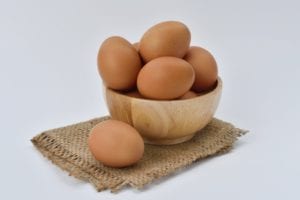It can be very satisfying to produce your own eggs either from free-range birds or from confined hens but make sure that you have done your homework before you start.
All hens will need to have a safe place to roost at night, out of the weather and away from predators. A shed 2m by 2m by 2.5m high will be sufficient for up to 8 chickens. It should be dry and weatherproof, but well ventilated. Tin sheds can become unbearably hot in summer. Water must be available for drinking at all times, and grit should be supplied. Perches are best made of untreated timber, and 3 to 4cm diameter are preferred. Provide plenty of perches, because the ‘boss’ hen will prevent others perching near her. The floor can be of earth or concrete. Concrete will be easier to clean. Untreated wood shavings or sawdust on the floor will absorb droppings but will need to be dug out and replaced when dirty (4-8 weekly). If the hens are to free-range, they can be shut into such a shed at dusk, and released again after feeding in the morning. Hens that are to be confined, even for half a day until they have laid, will need more space than this.
Female chickens can be expected to begin lying at around 6 months of age if well fed. The best layers are those breeds that have been developed for commercial egg production, currently Red Shavers. These can be bought from commercial egg producers as ‘point of lay pullets’ (young hens about to start laying) or as hens that have laid one season and would be culled by the egg producer, but will produce quite well in a small flock. Obviously, the pullets are more expensive than the older hens ($15 versus $5 approximately). When a hen is about to start laying eggs, her comb and wattles (bits on her head) will become bright red and plump. She will lay one egg every 25 hours, usually in the morning. Thus every so often she will miss one day and lay early the next morning. If nice dry nest boxes with clean hay are provided, she will probably lay in them, but may lay on the floor or make her own ‘secret nest’ if the nest boxes are dirty or insufficient. It is best to leave one egg (or a plastic egg shape) in the nest box to encourage her to continue to lay there. Use rat bait in hen-proof bait stations round the hen house to prevent rats eating the eggs.
Information supplied by Dawn Mills, BVSc, New Plymouth.
